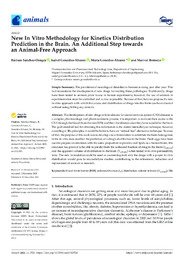Por favor, use este identificador para citar o enlazar este ítem:
https://hdl.handle.net/11000/34713Registro completo de metadatos
| Campo DC | Valor | Lengua/Idioma |
|---|---|---|
| dc.contributor.author | Sánchez-Dengra, Bárbara | - |
| dc.contributor.author | González Álvarez, Isabel | - |
| dc.contributor.author | Bermejo, Marival | - |
| dc.contributor.author | González Álvarez, Marta | - |
| dc.contributor.other | Departamentos de la UMH::Ingeniería | es_ES |
| dc.date.accessioned | 2025-01-16T18:49:53Z | - |
| dc.date.available | 2025-01-16T18:49:53Z | - |
| dc.date.created | 2021-12-10 | - |
| dc.identifier.citation | Animals 2021;11:3521 | es_ES |
| dc.identifier.issn | 2076-2615 | - |
| dc.identifier.uri | https://hdl.handle.net/11000/34713 | - |
| dc.description.abstract | The development of new drugs or formulations for central nervous system (CNS) diseases is a complex pharmacologic and pharmacokinetic process; it is important to evaluate their access to the CNS through the blood–brain barrier (BBB) and their distribution once they have acceded to the brain. The gold standard tool for obtaining this information is the animal microdialysis technique; however, according to 3Rs principles, it would be better to have an “animal-free” alternative technique. Because of that, the purpose of this work was to develop a new formulation to substitute the brain homogenate in the in vitro tests used for the prediction of a drug’s distribution in the brain. Fresh eggs have been used to prepare an emulsion with the same proportion in proteins and lipids as a human brain; this emulsion has proved to be able to predict both the unbound fraction of drug in the brain (fu,brain) and the apparent volume of distribution in the brain (Vu,brain) when tested in in vitro permeability tests. The new formulation could be used as a screening tool; only the drugs with a proper in vitro distribution would pass to microdialysis studies, contributing to the refinement, reduction and replacement of animals in research. | es_ES |
| dc.format | application/pdf | es_ES |
| dc.format.extent | 15 | es_ES |
| dc.language.iso | eng | es_ES |
| dc.publisher | MDPI | es_ES |
| dc.rights | info:eu-repo/semantics/openAccess | es_ES |
| dc.rights | Attribution-NonCommercial-NoDerivatives 4.0 Internacional | * |
| dc.rights.uri | http://creativecommons.org/licenses/by-nc-nd/4.0/ | * |
| dc.subject | blood–brain barrier (BBB) | es_ES |
| dc.subject | unbound fraction (fu) | es_ES |
| dc.subject | distribution volume in brain (Vu,brain) | es_ES |
| dc.subject | 3Rs | es_ES |
| dc.subject.other | CDU::6 - Ciencias aplicadas::62 - Ingeniería. Tecnología | es_ES |
| dc.title | New In Vitro Methodology for Kinetics Distribution Prediction in the Brain. An Additional Step towards an Animal-Free Approach | es_ES |
| dc.type | info:eu-repo/semantics/article | es_ES |
| dc.relation.publisherversion | https://doi.org/10.3390/ani11123521 | es_ES |

Ver/Abrir:
animals-11-03521-v2.pdf
10,04 MB
Adobe PDF
Compartir:
 La licencia se describe como: Atribución-NonComercial-NoDerivada 4.0 Internacional.
La licencia se describe como: Atribución-NonComercial-NoDerivada 4.0 Internacional.
.png)